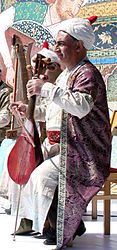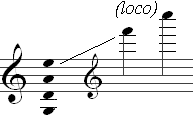
A mandolin is a stringed musical instrument in the lute family and is generally plucked with a pick. It most commonly has four courses of doubled strings tuned in unison, thus giving a total of eight strings. A variety of string types are used, with steel strings being the most common and usually the least expensive. The courses are typically tuned in an interval of perfect fifths, with the same tuning as a violin. Also, like the violin, it is the soprano member of a family that includes the mandola, octave mandolin, mandocello and mandobass.
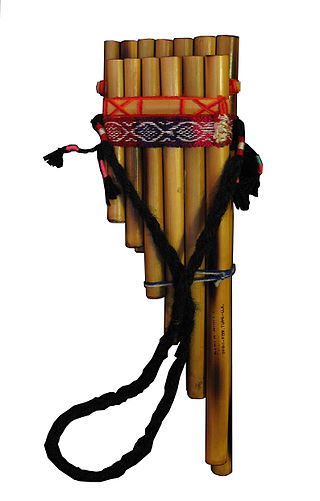
A pan flute is a musical instrument based on the principle of the closed tube, consisting of multiple pipes of gradually increasing length. Multiple varieties of pan flutes have been popular as folk instruments. The pipes are typically made from bamboo, giant cane, or local reeds. Other materials include wood, plastic, metal, and clay.
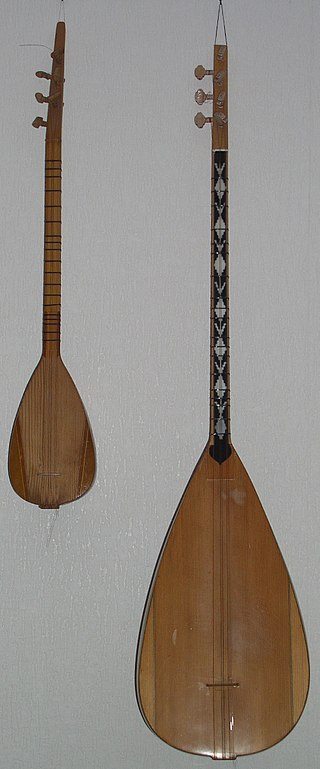
The bağlama or saz is a family of plucked string instruments and long-necked lutes used in Ottoman classical music, Turkish folk music, Turkish Arabesque music, Azerbaijani music, Bosnian music (Sevdalinka), Kurdish music, and Armenian music. It is played in several regions in the world such as Europe, Asia, Black Sea, Caucasus regions and many countries including Syria, Iraq, Iran and Bosnia and Herzegovina. It is commonly used by the ashiks.

The ney, is an end-blown flute that figures prominently in traditional Persian, Turkish, Jewish, Arab, and Egyptian music. In some of these musical traditions, it is the only wind instrument used. The ney has been played for over 4,500 years, dating back to ancient Egypt, making it one of the oldest musical instruments still in use.

The kaval is a chromatic end-blown oblique flute traditionally played throughout the Balkans and Anatolia. The kaval is primarily associated with mountain shepherds.

The kamancheh is an Iranian bowed string instrument used in Persian, Azerbaijani, Armenian, Kurdish, Georgian, Turkmen, and Uzbek music with slight variations in the structure of the instrument. The kamancheh is related to the rebab which is the historical ancestor of the kamancheh and the bowed Byzantine lyra. The strings are played with a variable-tension bow.

The komuz or qomuz is an ancient fretless string instrument used in Central Asian music, related to certain other Turkic string instruments, the Mongolian tovshuur, and the lute.

A tiple, is a plucked typically 12-string chordophone of the guitar family. A tiple player is called a tiplista. The first mention of the tiple comes from musicologist Pablo Minguet e Irol in 1752. Although many variations of the instrument exist, the tiple is mostly associated with Colombia, and is considered the national instrument. The Puerto Rican version characteristically has fewer strings, as do variants from Cuba, Mallorca, and elsewhere among countries of Hispanic origin.

The tar is a long-necked, waisted lute family instrument, used by many cultures and countries including Iran, Azerbaijan, Uzbekistan, Armenia, Georgia, Tajikistan, Turkey, and others near the Caucasus and Central Asia regions. The older and more complete name of the tār is čahārtār or čārtār, meaning in Persian "four string",. This is in accordance with a practice common in Persian-speaking areas of distinguishing lutes on the basis of the number of strings originally employed. Beside the čārtār, these include the dotār, setār, pančtār, and šaštār or šeštār.
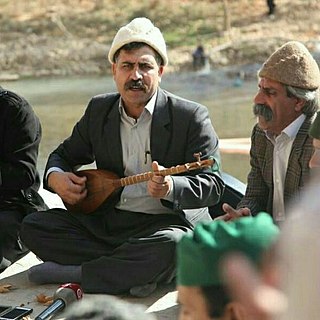
The term Tanbur can refer to various long-necked string instruments originating in Mesopotamia, Southern or Central Asia. According to the New Grove Dictionary of Music and Musicians, "terminology presents a complicated situation. Nowadays the term tanbur is applied to a variety of distinct and related long-necked lutes used in art and folk traditions. Similar or identical instruments are also known by other terms." These instruments are used in the traditional music of Iran, Iraq, India, Armenia, Afghanistan, Azerbaijan, Pakistan, Turkey, Tajikistan, Kazakhstan, and Uzbekistan.
The rud is a Persian stringed musical instrument. In Persian, the word means "string". It has been mentioned in classical Persian literature by Rudaki, Hafez, Naser Khusraw, Sanai, Ferdowsi, Nizami and Qatran Tabrizi other poets. The Arabic 'Ud, whose etymology is not yet convincingly explained, may well have been derived from the Persian word rud.

Balaban or balaman is cylindrical-bore, double-reed wind instrument about 35 centimetres (14 in) long with eight finger holes and one thumb hole. This instrument is played in the eastern part of Iran's historic Azerbaijan region as well as in the Republic of Azerbaijan. Balaban, Mey, and Duduk are almost identical, except for historical and geographical differences.

The choghur is a plucked string musical instrument common in Azerbaijan and Georgia. It has 4 nylon strings.

The Lagguti, Lakto, or Laggutu is a Talysh folk percussion slit drum instrument performed in southern regions of Azerbaijan: Lerik, Astara, Lankaran, Masalli and Jalilabad.

The temir komuz is a Kyrgyz jaw harp, while the komuz is a three-stringed fretless lute. As an instrument, the temir komuz is unrelated to the komuz in terms of style and structure; however, it takes its name from the other popular Turkic instrument.

The dutar is a traditional Iranian long-necked two-stringed lute found in Iran and Central Asia. Its name comes from the Persian word for "two strings", دوتار do tār, although the Herati dutar of Afghanistan has fourteen strings. Dutar is very popular in Tajikistan and Khorasan province of Iran. When played, the strings are usually plucked by the Uyghurs of Western China and strummed and plucked by the Tajiks, Turkmen, Uzbeks. Related instruments include the Kazakh dombra. The Dutar is also an important instrument among the Kurds of Khorasan amongst whom Haj Ghorban Soleimani of Quchan was a noted virtuoso. In Kurdish one who plays the dutar is known as a bakci (bakhshi) similar to Turkmen bagşy, while in Azeri the term is ashiq. Khorasan bakhshi music is recognized on the Representative List of the Intangible Cultural Heritage of Humanity.

The Azerbaijani Tar is a long-necked, plucked lute, traditionally crafted, and performed in communities throughout the Republic of Azerbaijan. The tar is featured alone or with other instruments in numerous traditional musical styles. It is also considered by many to be the country's leading musical instrument. The tar and the skills related to this tradition play a significant role in shaping the cultural identity of Azerbaijanis.

Azerbaijani traditional musical instruments are a family of ancient string, wind and percussion instruments used in the performance of Azerbaijani traditional music.
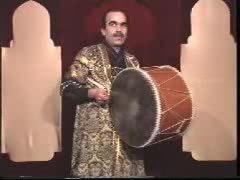
The Böyük nağara, also called the "kos nağara" or "wedding nağara", is a large double-headed drum. It is played with mallets. The böyük nağara is played in some regions of Azerbaijan. Its body is cylindrical and made from firm wood. Skins are stretched over both the top and the bottom of the cylindrical body of the instrument. Its diameter is 400–450 mm, and its height is 500–550 mm.
The Cura nagara is a folk drum used in the traditional music of Azerbaijan. Since it is smaller than the main nagara, it is called "cura" nagara. The diameter of its body is 300–320 mm, and its height is 340–360 mm.
